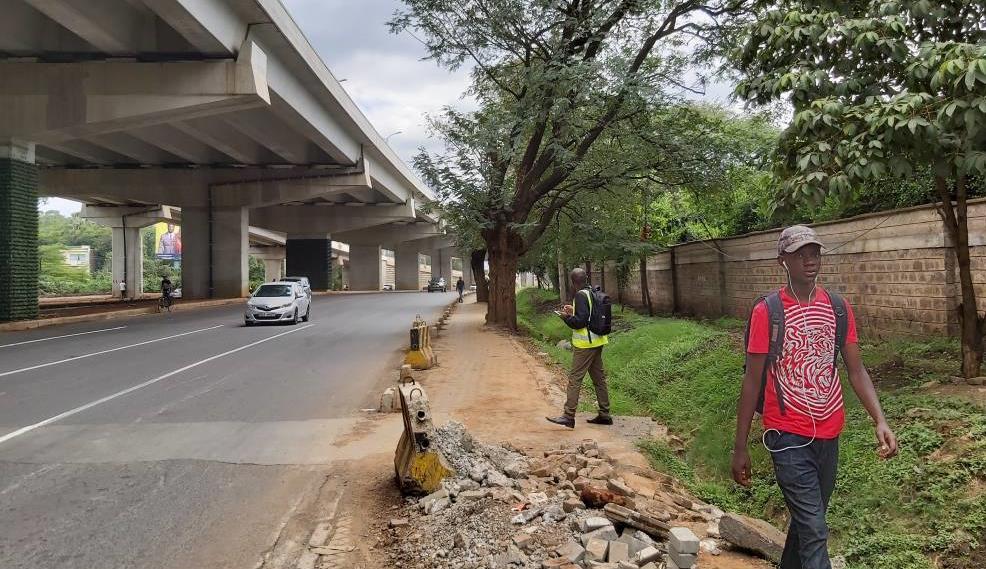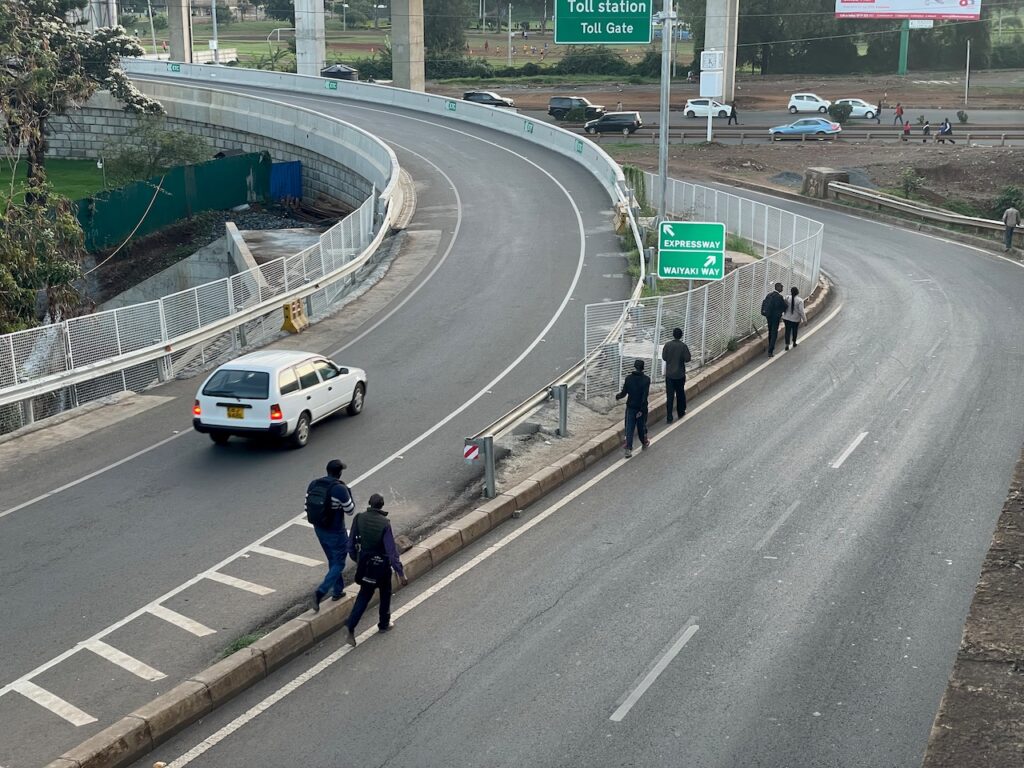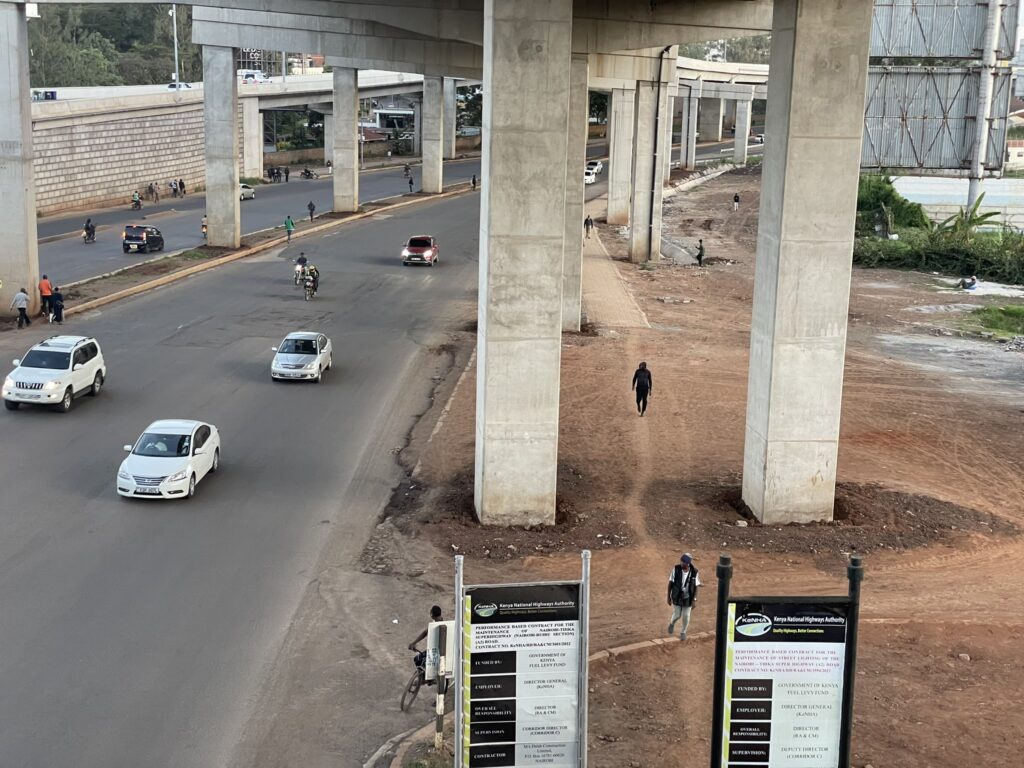
April 30, 2023
In an era of climate change, the Nairobi Expressway could still be a green corridor
The Nairobi Expressway, implemented under a build-operate-transfer model by China Road and Bridge Corporation (CRBC), is arguably Kenya’s most distinct private-public partnership project. While the project is popular with motorists, public transport users, pedestrians, and cyclists continue to face daily challenges while travelling on the corridor. As Nairobi and other African cities shift toward modern urban infrastructure and public-private partnerships, it is key to rethink the needs of urban residents and prioritise more equitable investments in urban mobility.
The trend toward car-centric design in Nairobi and other cities undermines the quality of life and character of public spaces. Designing for fast speeds in urban areas makes pedestrian crossings less safe, thereby blocking access to services, trade and commerce. Residents face harsh commutes without basic amenities such as bus shelters and walkways, leading more and more people to use private vehicles, further exacerbating traffic congestion.
The design of urban streets should balance the needs of all users, unlike the design of intercity roads, which are primarily geared toward facilitating fast vehicle movement. Effective urban street design ensures safety for all, particularly pedestrians and cyclists, and facilitates efficient use of road space by prioritising public transport. It is essential that cities plan and design functional transport networks based on current and anticipated commute patterns. This should be done by analysing the community needs, travel patterns, street uses, and existing mode choices.
Currently, plans are underway to rehabilitate the lower section of the expressway, with the relevant authorities mulling over plans to build drainage, install lighting, and re-carpet the old carriageway. The rehabilitation is a great opportunity to go beyond car-centric planning and redesign the corridor for equity, efficiency, and inclusion by prioritising walking, cycling and public transport—the dominant modes of transport in Kenyan cities. In Nairobi, 40 percent of daily trips are accomplished by foot and another 41 percent are made with public transport. Only 13 percent of trips are by car.
Nairobi, like many rapidly growing African cities, needs strategic planning towards a more efficient public transport system. This is only possible through the provision of bus rapid transit (BRT) on high-demand corridors and basic public transport amenities such as bus shelters and terminals on other routes. The rehabilitation of the expressway should include an in-depth analysis of commuter needs, including boarding and alighting locations and transfer patterns. The A8 road is a gazetted BRT corridor and the rehabilitation should include provisions for high-quality BRT infrastructure, including dedicated median lanes and stations and intersection designs that prioritise buses. Express BRT services can run on the expressway and access stops and stations on the lower road as needed. This will ease congestion on the lower road and improve commutes for public transport users.
The expressway made it even more difficult for pedestrians and cyclists to cross the road. In areas where the expressway is elevated, pedestrian crossings should be at grade, enabling ease of movement for public transport users and pedestrians.

Crossings should be located at pedestrian desire lines, with universal access and adequate drainage to prevent water logging. In addition, raised crossings or marked speed humps should be erected in order to reduce vehicle speeds. With the expressway accommodating high-speed vehicles, the lower road should offer a more conducive environment for pedestrians and cyclists to interact with the street.

Most of the footpaths on Uhuru Highway and Waiyaki Way were demolished to pave the way for the construction of the Expressway, and very few have been rehabilitated. Where footpaths exist, the available clear width is inadequate and the footpaths often end abruptly with numerous obstructions including expressway columns, utility poles, and construction debris blocking access.

In addition, cars and boda bodas use walkways to avoid traffic along some stretches of Waiyaki Way and Uhuru Highway, hindering pedestrian mobility. Lack of universal access forces disabled pedestrians to use the carriageway next to fast-moving vehicles, creating safety concerns. To improve the situation, well-designed footpaths with at least 2 m of clear space should be implemented. To reduce waterlogging, footpaths should be raised above the carriageway. Kerbs and bollards should be installed to prevent encroachment from vehicles.
Cycling as an option for short trips and first- and last-mile access can be actualised with the implementation of well-designed safe cycle tracks. The inclusion of cycle tracks along the A8 would encourage cycling and ease congestion in areas such as Westlands, Upper Hill, Ngong Road, Industrial Area, Nairobi West, Eastlands, South B, and South C. Cycle tracks should be constructed with smooth service material such as asphalt or concrete and should be physically separated from the carriageway for safety. A comfortable minimum width is 2 m.
For both walking and cycling, adequate shade offers a comfortable and aesthetically pleasing environment in addition to improving the overall city look and feel. Moving forward, it is essential that the existing tree canopy cover is improved by planting street trees. Mature, healthy trees act as green infrastructure, reducing the heat island effect in the city while also improving the air quality by mitigating the effects of pollution.
With Kenya’s urban population projected to exceed 22 million by 2030, connectivity to education, employment, and social opportunities is fundamental to the development of the country. It is key that urban transport facilities and services, including the Expressway corridor, enable citizens to access opportunities safely and efficiently.
Learn more on the Nairobi Expressway Audit here
